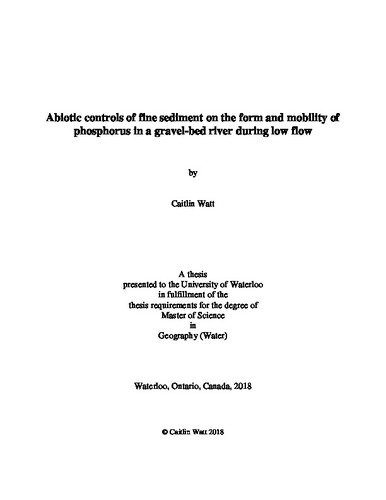| dc.contributor.author | Watt, Caitlin | |
| dc.date.accessioned | 2018-06-18 14:50:41 (GMT) | |
| dc.date.available | 2018-06-18 14:50:41 (GMT) | |
| dc.date.issued | 2018-06-18 | |
| dc.date.submitted | 2018-06-08 | |
| dc.identifier.uri | http://hdl.handle.net/10012/13411 | |
| dc.description.abstract | Landscape scale disturbance in forested source water regions can accelerate the transfer of fine sediment and associated phosphorus (P) to receiving streams and degrade water quality in downstream environments for human and ecosystem use. The abiotic controls of deposited riverbed and suspended fine sediment on the form and mobility of P were examined in an oligotrophic gravel-bed river undergoing cumulative downstream sediment pressures from disturbance (e.g., harvesting, wildfire and sewage effluent) in Alberta, Canada. The spatial distribution of particulate P forms (NAIP, AP, OP) and major element composition were assessed across six study sites in the Crowsnest River that receive tributary inputs from watersheds that have experienced a range of landscape disturbance types. Pore-water soluble reactive P (SRP) concentration profiles within the gravel-bed were measured with pore-water peepers. Diffusive fluxes from the sediment to the water column were related to landscape disturbances, substrate properties, dissolved oxygen concentrations, and fine sediment sorption characteristics. A series of batch experiments were conducted to determine the Equilibrium Phosphate Concentration (EPC0) and evaluate the potential of fine sediment to influence P concentrations in the overlying water column. Results of the study demonstrated varying sensitivities to landscape disturbances due to the heterogeneous nature of gravel-bed substrate and morphology. Macro- to micro-scale processes influenced the form and mobility of P, however fine sediments in the riverbed irrespective of landscape disturbance demonstrated the potential of the riverbed to release SRP to the water column. Sewage inputs had the greatest impact on SRP fluxes from the riverbed and bioavailability of P in suspended sediments. The most bioavailable form of particulate P (NAIP) was associated with metal oxide and organic carbon coatings on sediment. Lower dissolved oxygen concentrations are likely responsible for driving the release of P from redox sensitive metals. Bioavailable particulate P and the release of SRP can influence in-stream water quality and ecological communities, and over longer time scales can propagate effects downstream to reservoirs and impact drinking water supplies. This thesis provides new knowledge regarding the impacts of both landscape disturbance and site-specific abiotic processes that influence the form and mobility of P in a gravel-bed river during the biologically sensitive period of summer low flow. | en |
| dc.language.iso | en | en |
| dc.publisher | University of Waterloo | en |
| dc.subject | Fine sediment | en |
| dc.subject | Suspended sediment | en |
| dc.subject | Riverbed sediment | en |
| dc.subject | Gravel-bed river | en |
| dc.subject | Phosphorus pore-water | en |
| dc.subject | Equilibrium phosphorus concentration | en |
| dc.subject | Particulate phosphorus forms | en |
| dc.subject | Major element composition | en |
| dc.subject | Landscape disturbance | en |
| dc.title | Abiotic controls of fine sediment on the form and mobility of phosphorus in a gravel-bed river during low flow | en |
| dc.type | Master Thesis | en |
| dc.pending | false | |
| uws-etd.degree.department | Geography and Environmental Management | en |
| uws-etd.degree.discipline | Geography (Water) | en |
| uws-etd.degree.grantor | University of Waterloo | en |
| uws-etd.degree | Master of Science | en |
| uws.contributor.advisor | Stone, Michael | |
| uws.contributor.affiliation1 | Faculty of Environment | en |
| uws.published.city | Waterloo | en |
| uws.published.country | Canada | en |
| uws.published.province | Ontario | en |
| uws.typeOfResource | Text | en |
| uws.peerReviewStatus | Unreviewed | en |
| uws.scholarLevel | Graduate | en |

